Olive oil has had pride of place in the Land of Israel for millennia. It is one of the three main products of the land and was used in every household as well as in the Temple (for more on olive oil see here). But how was this oil actually produced? Our Mishnah lists the components of the olive press, the bet bad:
“MISHNA: One who sells an olive press has sold with it the yam and the memel and the betulot,. But he has not sold with it the avirim and the galgal and the kora,” (Bava Batra 67b)
In order to understand these terms we need to take a deep dive into olive oil production. The basic process remained the same throughout the ages, but the mechanisms developed and became more sophisticated.
To make oil you need to harvest the olives and crush them. In the language of the Mishnah this is called techina, grinding. After they are crushed and a small amount of high quality oil is gathered, the olive pulp is placed in baskets with a hole or weave that allows liquid to flow out.
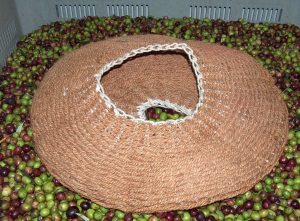
Giancarlo Dessi via Wikimedia Commons
The baskets are placed above a pit that the oil will collect in. These baskets are then squeezed to extract the oil. This stage is called teina, pressing. The squeezing can be done multiple times, each subsequent time will produce lower quality oil. Finally all you are left with is gefet, the solid residue of the olive after all the oil is pressed out. This gefet produces heat and so it should not be left next to someone’s house (Mishnah Bava Batra 2:1) or used to insulate your cooking pots on Shabbat (Mishnah Shabbat 4:1).
A great illustration of these stages is in the Mishnah in Menachot, which enumerates the types of oil and which ones are worthy of being used in the Temple:
“There are three harvests of olives each year, and in each of them, three different grades of oils are produced. How is the first olive harvest processed? One picks the ripe olives at the top of the olive tree, and crushes them in a mortar and places them inside a wicker basket . . .This is the first grade of oil. One then presses down with a beam . . .this is the second grade of oil. One then ground and pressed down; this is the third grade of oil. The first grade is fit for the Menora, and the rest are fit for use in meal offerings.” (Menachot 8:4)
In ancient times and in primitive societies, the crushing stage was done by putting the olives on a rock and pounding them with a second rock. The process of pressing was also simple: put the baskets above a pit, place wooden plates on top to weigh down the baskets, and let the oil ooze out. Eventually the oil in the pit will rise and separate from the remaining gunk underneath and it can be skimmed off and used.
By Hellenistic times (third century BCE), people had developed a stone holder for the olives with another stone on top, held in place by a beam and rotated by an animal to crush the olives:
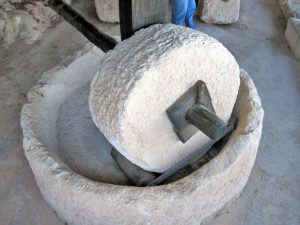
Tamar haYardeni via Wikimedia Commons
By late Second Temple times (first century CE) the press was improved. A beam was placed above the baskets, held in place on one side by a hole in a wall. On the other end, weights were placed that could be raised and lowered. This made the whole process more efficient and also extricated more oil. Because of that, in shmitta years when you needed to do things differently, you had to go back to the old methods:
“Olives may not be prepared in an olive-press or in a small olive-press, but he may crush them and bring them into a small olive-press in the field.” (Sheviit 8:6)
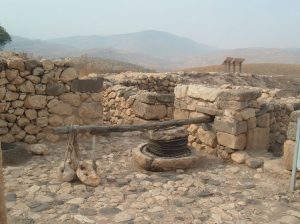
Almog, Public domain, via Wikimedia Commons
By Byzantine times (fourth century CE) a new innovation was introduced. Instead of a beam, there was a screw above the baskets and it could be lowered and tightened to extract the oil:
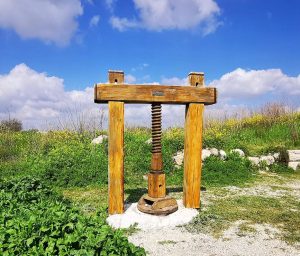
Heritage Conservation Outside The City Pikiwiki Israel, CC BY 2.5 <https://creativecommons.org/licenses/by/2.5>, via Wikimedia Commons
These methods were in use in the Land of Israel up until the last century but today they have almost completely disappeared. However, the remains of many presses have been found and they help us to reconstruct what the Mishnah is describing.
What do the words of our Mishnah mean? Let’s start with the press itself, the bet bad בד .בית הבד is a fascinating word. It has many meanings and they are connected. The one most relevant for us is poles or sticks, as in the badim used to carry the Ark of the Covenant:
וְעָשִׂ֥יתָ בַדֵּ֖י עֲצֵ֣י שִׁטִּ֑ים וְצִפִּיתָ֥ אֹתָ֖ם זָהָֽב׃
Make poles of acacia wood and overlay them with gold; (Shmot 25:13)
The bet bad’s main element is the beam, or בד in Torah terms. Without it the press could not function. This is why Rabbi Eliezer in our Mishnah says that the korah, the beam, is always included in the sale of the press because it is the essential element of the whole thing.
We also have the phrase בד בבד where the Torah describes the ingredients for the incense (Shmot 30:34); here it seems to mean equally but may also mean one by one. This connects us to another word: בדד or לבד – alone, as in עם לבדד ישכון, a people that dwells alone (Bamidbar 23:9). Finally, bad also means material, something that is woven out of single pieces of thread.
The other words are more complex. The principle of the Mishnah seems to be that the items included in the sale are the immovable parts of the press. The Bavli’s way of explaining these parts is like this:
Yam: the stone bowl where the olives are first placed.
Memel: the stone above that crushes the olives
Betulot: wooden beams that hold the main beam in place
Akir (the correct version, not avir): the boards placed over the baskets before the weight is put on
Galgal: a humrata: Rashbag explains this as the screw, which fits with our description. Others explain it as a rope to maneuver the beam:
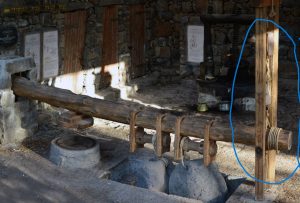
Staselnik, CC BY-SA 3.0 <https://creativecommons.org/licenses/by-sa/3.0>, via Wikimedia Commons
Finally, the korah- the beam, the most important part.
Interestingly, the Gemara brings a Tosefta which adds and changes some of the elements, perhaps reflecting more of the Eretz Yisrael tradition than what we find in the Bavli:
תָּנוּ רַבָּנַן: הַמּוֹכֵר בֵּית הַבַּד – מָכַר אֶת [הַ]נְּסָרִים, וְאֶת הַיְּקָבִים, וְאֶת הַמַּפְרֵכוֹת, וְאֶת הָרֵיחַיִם הַתַּחְתּוֹנוֹת – אֲבָל לֹא הָעֶלְיוֹנָה.. בֵּין כָּךְ וּבֵין כָּךְ – לֹא מָכַר לֹא אֶת הָעֲבִירִים, וְלֹא אֶת הַשַּׂקִּין, וְלֹא אֶת הַמַּרְצוּפִין
“One who sells an olive press has sold with it the boards [that are fixed in place to hold the olives;] and the vats, and the crushers, and the lower millstone, but not the upper millstone. . . he has not sold the wooden boards [that are placed on top of the crushed olives when they are being pressed,] nor the sacks, nor the leather bags” (Bava Batra 67b)
The Tosefta does not mention the yam and the memel but rather the upper and lower millstones, what we have translated as yam and memel. The lower (the bowl or as the Bavli says it, the yam) is included, the upper (the crusher or what we called the memel) is not. This fits nicely with our separation of the Mishnah into immovable and movable parts. Dr. Rafael Frankel, the expert on ancient olive presses in Israel, explained that although almost everyone calls the bowl and crusher a yam and memel, this is incorrect. According to him, the bowl and crusher are the millstones, as the Tosefta has it. The yam is the pit where the oil collects (or the yekev as in the Tosefta) and the memel is the surface where the oil is pressed. These are both immovable which makes our Mishnah more understandable.
Whether you agree with the Bavli’s definition of a memel as a mafrecha, a crusher, or not, it is nice to note the name of the rabbi providing that explanation:
“The memel, Rabbi Abba bar Memel said: This is the crusher”
The Jewish people has been compared to the olive. This powerful Midrash expands that metaphor to include all the stages we have been discussing:
“Rather, just as the olive, while it is on the tree one picks it, then one takes it down from the tree and it is beaten, and after it is beaten, it is taken up to the olive press and placed into the mill where one grinds it, then one surrounds it with ropes, brings stones, and then they produce their oil. So too, Israel: idolaters come and beat them from place to place, incarcerate them, bind them in chains, and surround them with fences. Then they repent and the Holy One blessed be He answers them.” (Shemot Rabba 36:1)

שומבלעCC BY-SA 2.5 <https://creativecommons.org/licenses/by-sa/2.5>, via Wikimedia Commons










